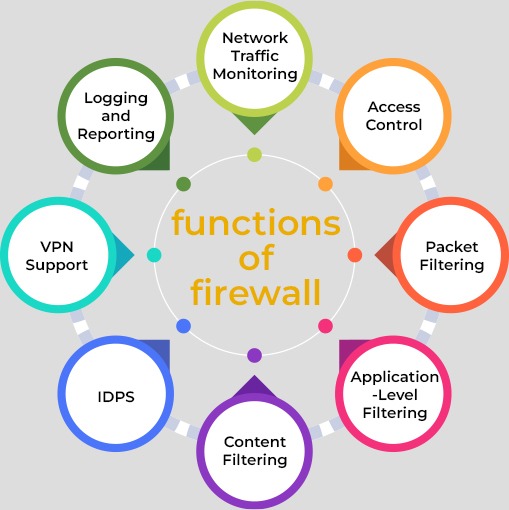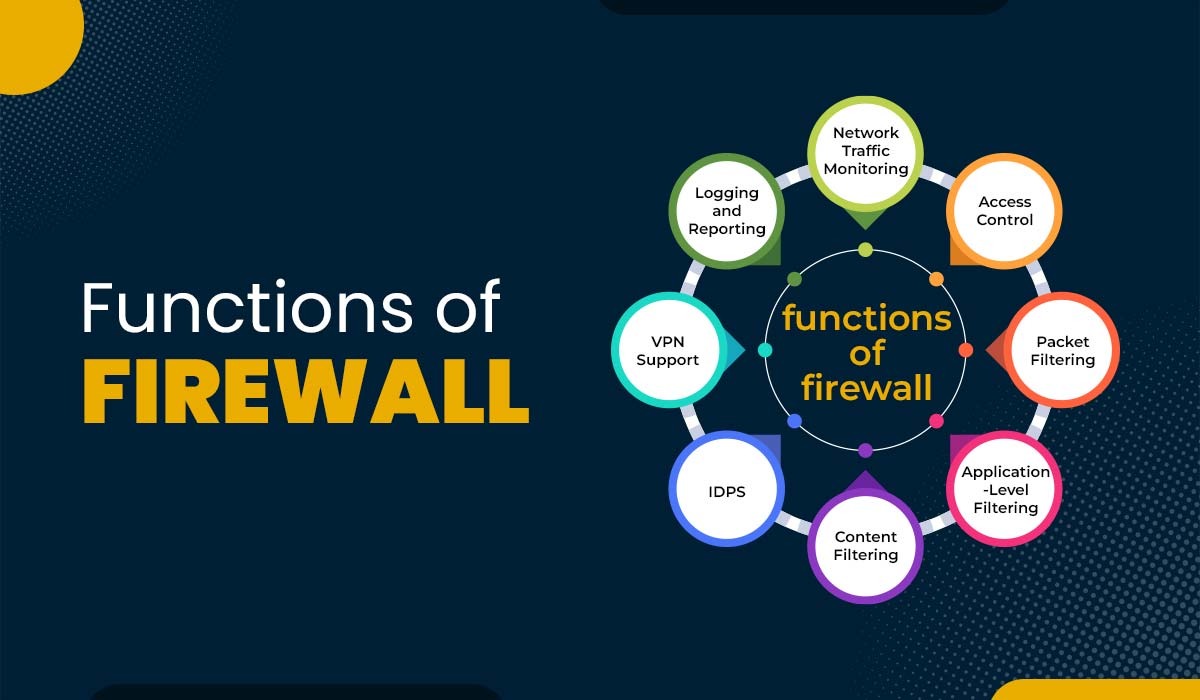Introduction
Nowadays, network security is one of the biggest concerns. This is due to increased Internet usage for various purposes, such as e-commerce, online banking, remote work, and social networking. From big corporations utilizing computer servers to individual smart gadgets, nobody wants to lose their data. But how can you protect your network from unwanted access, malicious attacks, and data breaches? Well, lucky for all of us, firewalls help with all that.
A firewall is the first barrier to malicious attacks, unauthorized access, and other security threats. But wait, there is more; firewalls come with loads of functionalities that assist in administering your network, plus their efficiency. In this blog, we will outline the functions of firewall and explain how it can help secure your network.
Before getting into the main function of firewall, let us first understand what a firewall is.
What is a Firewall?
A firewall is a safety mechanism that may be hardware or software-based, mostly for safety measures. Its primary purpose is to ensure that only authorized persons can access a computer or a network. It mediates between a private network and the public Internet to regulate traffic access according to a given security policy.
Hardware firewalls act as physical barriers between the network and the Internet, whereas software firewalls are add-on programs for PCs or network computers. A firewall can be imagined as a guard that stands between a private network and the public Internet and allows only such traffic to cross this barrier.
Firewalls function by examining the flows of network packets or data packets that circulate in a network. They determine whether to let a packet pass through or not, depending on set security parameters. This can involve analyzing the source and destination of the packet, the communication protocol used, and the content of the message.
There are different types of firewalls, including:
- Packet filtering Firewall
- Proxy Service Firewall
- Stateful Inspection Firewall
- Circuit-level Gateways Firewall
- Next-Generation Firewall (NGFW)
- Software firewalls
- Hardware firewalls
- Cloud firewalls
Now, let us move on to firewall functions to understand how they assist businesses and individuals in getting smooth and secure networks.
What are the Functions of Firewall?
The main function of a firewall is to provide security. These systems offer numerous purposes that directly improve the network’s security, manageability and performance. Below we have explained some of the other firewall functions.

Network Traffic Monitoring
A significant function of firewall is to regulate traffic movement between the private network and the public Internet. Firewalls parse every packet of information that wants to enter or exit through the firewall, checking the source and destination address as well as the protocol being used. This packet is compared with the pre-existing security rules set; if the firewall approves, the packet is passed; otherwise, it is blocked.
Access Control
Firewalls help regulate who can access your network and what level of freedom one has within it. By using access rules, you can decide who or what may be connected to your network. For instance, you can enable only specific users to view some data and disable others.
Access control is described as a permission list for your network known as Access Control List. Just like the door of a house is locked for people you don’t know or are not related to you, a firewall only permits those who are allowed to be inside the network.
Packet Filtering
Packet filtering is used in firewalls to examine network traffic at the packet level. Firewalls analyze packets by first examining them at the header level, which is made of the information transmitted with every packet; it contains the source and destination IP addresses. Then, firewalls analyze the communication protocol and the port numbers in use.
The packet data presented here can then be used by firewalls and their related systems to filter and then take actions, i.e., “allow” or “deny” various types of traffic in compliance with the security policies. For instance, a firewall can be set to deny the connection of all traffic on the standard web port 80 to prevent hackers from gaining access to the hosts on the web servers.
Application-Level Filtering
Other than filtering at the packet level, today’s firewall extends its functionality by filtering at the application level. Firewalls do this by looking at the message content and context of the network traffic, not simply the header. This also enables them to monitor and deny or permit particular applications or services, such as web browsing, email, or file transfer protocol.
Application-level filtering via firewalls enforces security policies such as preventing access to specific websites or the use of certain applications.
Content Filtering
Another essential function of firewalls is that they can also be programmed to filter content based on different criteria. This function enables an organization or an individual to deny any IP address access to specific sites or content that is available online and believed to be prohibited or dangerous.
Content filtering is similar to parental control. In the same way, you would set parental control on TV or the Internet for your children, content filtering does the same for the entire network.
Intrusion Detection System and Intrusion Prevention System
Firewalls can also act as IDPS, short for intrusion detection and prevention systems. Thus, they can look for signs suggesting malicious activity like a network attack, unauthorized access attempt, or any strange activity on a network. When it comes to security threats, firewalls can act effectively and prevent or mitigate an attack, if any.
This intrusion detection and prevention capability helps protect the network and its connected devices against many types of cyber threats, such as DDoS, network malware, and unlawful access.
Virtual Private Network (VPN) Support
Today’s firewalls provide VPN solutions in their feature list as well as in the core functionality set. In the case of a VPN connection, the formation of a secure and encrypted tunnel between a user and the network is made by virtue of VPNs to enable the user to connect remotely to the network securely.
Firewalls that support VPN can assist an organization to expand its network perimeters and accommodate the actual users who have to or who wish to work remotely in the modern business environment.
Network Address Translation (NAT)
Another essential function of firewalls is that they contain NAT features that permit them to translate one network address scheme to another. This is especially true where a private network employs a different set of IPs than the public IP network.
When firewalls perform NAT, the internal actual topology of the network remains hidden from the global network, thus making it more secure. This can help to minimize direct access to inside devices from the Internet, thus decreasing the chances of being attacked.
Logging and Reporting
Firewalls typically include logging and reporting functionalities, which allow them to record and analyze network traffic and security events. This information can be used for various purposes, such as:
- Monitoring and auditing network activity
- Identifying and investigating security incidents
- Generating reports for compliance and regulatory purposes
- Optimizing firewall configurations and security policies
These are some of the main functions of firewall that help secure your private network and devices.
Frequently Asked Questions
Q1. What is the main function of a firewall?
The main function of firewalls is to protect the network from any cyber threat. This can be done by monitoring network traffic and taking action accordingly.
Q2. What is the function of Windows Firewall?
Windows Firewall helps monitor and control network traffic. It is responsible for the overall security of the computer and takes actions such as blocking unauthorized access attempts or penalizing any third party’s software and remove from the computer.
Q3. What are the benefits of a firewall?
Some of the benefits of a firewall are:
- Network security
- Data protection
- Malware blocking
- Unauthorized access prevention
Q4. What are the three types of firewalls?
The three types of firewalls are:
- Network-based firewall
- Application firewall
- Proxy Server
Conclusion
Firewalls are an important element that offers tons of services and functionalities to prevent various types of threats to people, companies, and institutions with interests in cyberspace. The main firewall functions include monitoring and controlling the traffic and maximizing security, performance, and policy compliance, all of which are meant to form part of your tightly integrated defense system.
By understanding the general functions of firewalls as well as the specific ways in which they can be applied as tools to increase your security, you will be able to plan and strategize for the challenges that can affect your business operations and your personal life.





